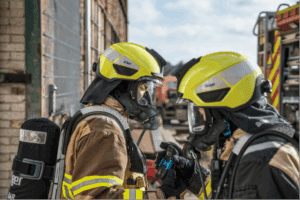Coopers Fire shares the importance of a fire evacuation checklist
It comes as a surprise that many people would not know what to do in the event of a fire or emergency. Less than 50% of building occupants feel confident of knowing what action to take and where to evacuate to during an emergency.
So, ensuring that one has a clear and simple evacuation plan in place will make all the difference if a fire were to occur – giving one and others a grasp of control should the situation arise.
Creating a fire evacuation plan is also necessary in order to comply with UK Fire Safety Legislation. Many benefits express the importance of a fire evacuation plan, here are just a few:
Establish a clear team of leaders
When an emergency occurs, most people in the workplace will likely be in a panic to leave the building as quickly as possible. However, being in a rush risks the possibility that people could injure themselves or cause damage to the property in the process.
An identifiable team of responsible leaders, who can coordinate everyone into a routine and ensure the evacuation is orderly and safe, need to be at the forefront of an evacuation.
Four main roles
Generally, four main roles will be required:
- The main point of contact: This is a role that includes communicating with emergency services and is the person who decides when an evacuation should take place.
- First aid assistants: Any injuries that can be treated with a first aid kit should be treated on-site by a first-aid assistant. This helps keep people safe before emergency services arrive, and there should be several appointed first-aid assistants at hand to help.
- Dedicated coordinator: When an evacuation takes place, the coordinator is responsible for completing the list of tasks, which include double-checking bathrooms and rooms for stragglers, and securing the site overall.
- Head counter: Head counters are responsible for making sure everyone is accounted for. If the workplace is large, it is recommended that one have several head counters, one for each department, that can report to a higher authority.
All workplaces will require each position, but one person can account for multiple roles within smaller buildings.
A designated location for evacuation
Every evacuation plan needs to clarify an outside meeting place where everyone in the building can go in the event of a fire. This detail will ensure everyone knows exactly where they need to be (and when) after an evacuation.
Staying in a group during the evacuation is crucial because it allows head counters to gain an accurate account of everyone who has left the building, also helping emergency services know whether there is anyone left in the building to rescue.
Media contact
Rebecca Morpeth Spayne,
Editor, International Fire Buyer
Tel: +44 (0) 1622 823 922
Email: [email protected]




































